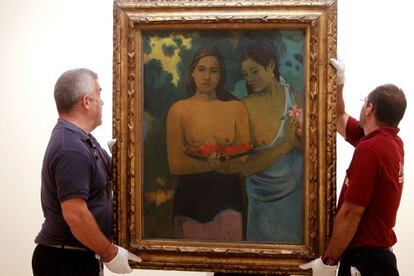Gauguin’s South Sea adventures
The Thyssen celebrates its 20th year with a show on the influential French artist

Two decades old this week, the Thyssen Museum in Madrid is celebrating its anniversary with a blockbuster show of 111 works narrating the artistic adventures and influence of Paul Gauguin (1848-1903).
The French artist has already been the subject of countless exhibitions around the world -- the museum devoted a complete retrospective to him in 2005 -- but as with Picasso, there are always new avenues to explore.
The point of departure of Gauguin and the Voyage to the Exotic is his first trip to Tahiti in 1891, where, aged 43 and suffering from syphilis, he went in search of the calm he needed to reinvent himself as a person and an artist.
The opening rooms show Gauguin's paradisiacal landscapes from that first voyage alongside similar scenes painted by his contemporary Charles Laval. "They are works in which Gauguin tells us what he would have liked to have found: an idyllic life that he had seen as a jump back, before 'civilization' arrived and prohibited [the natives'] dances and music," explains curator Paloma Alarcó.
After that come the paintings from his second, and definitive, voyage, which seem to contain the same elements but alongside symbols of evil that the colonizers and the Church inflicted on the natives. The wild freedom with which Gauguin employed color had a profound influence on French Fauvism and German Expressionism, and this occupies the latter part of the show, which runs until January 13.
Tu suscripción se está usando en otro dispositivo
¿Quieres añadir otro usuario a tu suscripción?
Si continúas leyendo en este dispositivo, no se podrá leer en el otro.
FlechaTu suscripción se está usando en otro dispositivo y solo puedes acceder a EL PAÍS desde un dispositivo a la vez.
Si quieres compartir tu cuenta, cambia tu suscripción a la modalidad Premium, así podrás añadir otro usuario. Cada uno accederá con su propia cuenta de email, lo que os permitirá personalizar vuestra experiencia en EL PAÍS.
¿Tienes una suscripción de empresa? Accede aquí para contratar más cuentas.
En el caso de no saber quién está usando tu cuenta, te recomendamos cambiar tu contraseña aquí.
Si decides continuar compartiendo tu cuenta, este mensaje se mostrará en tu dispositivo y en el de la otra persona que está usando tu cuenta de forma indefinida, afectando a tu experiencia de lectura. Puedes consultar aquí los términos y condiciones de la suscripción digital.
Últimas noticias
Pinochet’s victims grapple with José Antonio Kast’s rise in Chile
Reinhard Genzel, Nobel laureate in physics: ‘One-minute videos will never give you the truth’
How Japan is trying to avert ‘digital defeat’
The complicated life of Francesca Albanese: A rising figure in Italy but barred from every bank by Trump’s sanctions
Most viewed
- Pablo Escobar’s hippos: A serious environmental problem, 40 years on
- Why we lost the habit of sleeping in two segments and how that changed our sense of time
- Charles Dubouloz, mountaineering star, retires at 36 with a farewell tour inspired by Walter Bonatti
- Trump’s obsession with putting his name on everything is unprecedented in the United States
- The Florida Keys tourist paradise is besieged by immigration agents: ‘We’ve never seen anything like this’








































